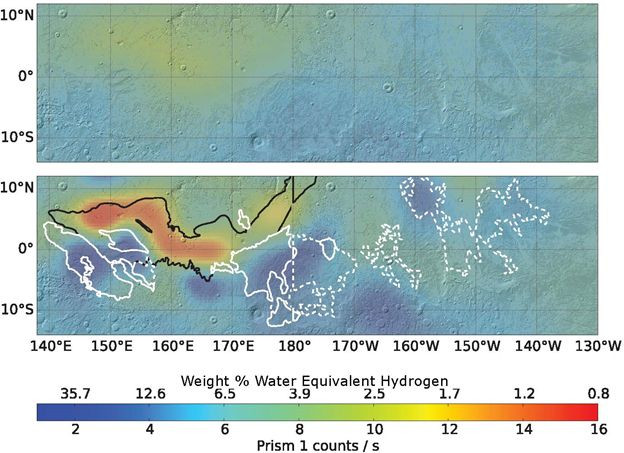Water On Mars: Odyssey Data Shows Underground Ice In Equatorial Region

The presence of water on Mars is old news now. Though this water existed millions of years ago, remains of frozen lakes and traces of water have been found on the red planet.
NASA’s Curiosity rover and the Odyssey spacecraft, currently in the orbit of the red planet, give us latest updates on the planet. With so much data and research pouring in from Mars, even old data on re-examination can lead to important new discoveries.
A team of space researchers, led by professor Jack Wilson from the Applied Physics Laboratory (APL) of Johns Hopkins University, has found large deposits of what could be permafrost ice in the unlikeliest of places on Mars, its equator.
The discovery was made in a region on the Martian equator called Medusae Fossae, which spans several hundred kilometers. This area had never been studied for ice content as it was considered too hot. For ice to remain in such a state in the warmer regions of the planet, points to a larger abundance of water than previously estimated.
A study published in Science Direct says permafrost ice has been spotted on Mars using data provided by the Odyssey spacecraft’s neutron spectrometer.
Initial data from NASA’s Phoenix lander from 2008 showed abundant water near the Mars’s poles. The ice was found mere centimeters below the surface and the same findings showed that ice wasn’t present near the equator region.
But, the team understood that the 2008 readings were very low resolution. The range was just 323.1 miles, meaning the smallest area the reading could focus on was 323.1 miles wide. However, the team obtained better resolutions by applying a mathematical method known as the Bayesian image reconstruction to narrow it down to 180.2 miles.
“It’s similar to lowering the altitude of the spacecraft by 50 percent,” said Wilson. “You’re getting a better view of what’s going on,” he said in a report by the Cosmos Magazine.
SpaceX CEO Elon Musk, at the International Astronautical Congress (IAC) in Adelaide, Australia, made important announcements about SpaceX’s ambitious Mars project. He claimed the company’s BFR rocket will begin fully fledged Mars mission as early as 2022!
What is interesting here is that the initial phase of the plan involves two cargo missions to scout water sources and build a fuel plant on the red planet, according to a report by Fortune .
Musk said he’s “confident” the plan will be under way within five years. Water is deemed crucial because the amount of water found, both as ice or heavily hydrated minerals, can be easily converted into rocket fuel.
According to Wilson, the ice “is in large part hydrogen and oxygen.” This, according to him, means that fuel for the mission to return from Mars could be generated on Mars itself, saving a lot of money on fuel transportation.
The ability to tap into vast pools of fuel in the form of ice on, even on the equator, on the Martian surface will add to the feasibility of future Mars missions, the team feels.
© Copyright IBTimes 2025. All rights reserved.



















